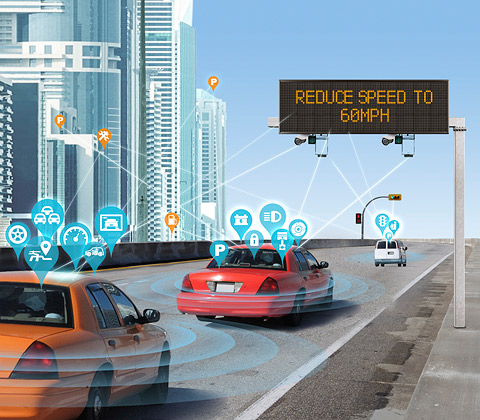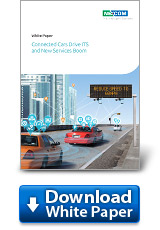Connected Cars Drive ITS and New Services Boom

Increasingly connected, cars are becoming mobile devices on wheels. Running alongside the internet of things, connected cars not only revolutionize intelligent transportation systems (ITS) but also provide drivers and passengers more innovative services.
These cars are made possible thanks to computerized in-vehicle terminals. With vehicle-to-vehicle (V2V) and vehicle-to-infrastructure (V2I) communications, they deliver smarter and safer driving experience with in-vehicle infotainment, navigation, vehicle diagnosis, and traffic updates.
Connected Cars Drive ITS Boom
Computerized terminals are no longer luxurious options. "The connected car is booming. In addition to automakers' endeavors like Ford Sync, General Motors OnStar, and Volvo On Call, Apple and Google unveiled automotive initiatives like Apple CarPlay and Android Auto. Automakers and Silicon Valley companies are extending their interactive offerings with built-in or brought-in solutions," said Steven Wu, GM of Mobile Computing Solutions Business Unit, NEXCOM.
With mobile device integration and wireless connection, these terminals meet various demands. Drivers can stream online music and share real-time location and estimated arrival time using location-based services like Glympse.
Through V2V and V2I communications, in-vehicle terminals update drivers with the latest traffic information including roadwork, road incidents, and traffic flow to help drivers avoid traffic congestion. When drivers approach their destination, these terminals automatically search and reserve the nearest available parking spot.
In-vehicle terminals send in-vehicle data over vehicle-to-Cloud (V2C) connection for further analysis, assisting in increasing fuel efficiencies, reducing repair costs, and improving road conditions. For instance, drivers can be notified with the latest vehicle information for preventive maintenance while transport departments can be informed about potholes for repairs.
Exceptional Experience in Every Way Possible
Connected cars make ITS possible and innovate the driving experience. According to Wu, car dashboards are becoming vehicles' control centers, boosting advanced driver assistance systems (ADAS) upgrades, and creating new business models.
With camera systems and sensor technology, ADAS reduces drivers' burdens with visual aiding applications like park assist, panoramic views, night visions, blind spot detection, driver drowsiness detection, collision avoidance, and lane departure warnings. It also integrates emergency vehicle notification system so that when collisions occur, the vehicle transmits its location to Emergency Services immediately. The dashboard also features intuitive interface with flexible scalability and concierge services that answer questions to location request and roadside assistance.
Also, digital dashboards support vehicle tracking, navigation, parking space finding, payment, and customer services, enabling car sharing services to lower vehicle ownership and consequently a smaller carbon footprint. NEXCOM is working with car sharing service providers for double DIN terminals. Besides passenger cars, NEXCOM also expands into coach market with smart entertainment terminals.
Passengers can also benefit from connected cars by enjoying media streaming services such as movies, music, and Karaoke. For business travelers, connected car can be mobile offices thanks to Internet connections for emails and videoconferencing.
Prevalence of connected cars revolutionizes ITS and provides more value-added services. As connected cars bring fun, intelligence, and enhanced safety, the opportunity for connected cars is vast and waiting to be explored.






















